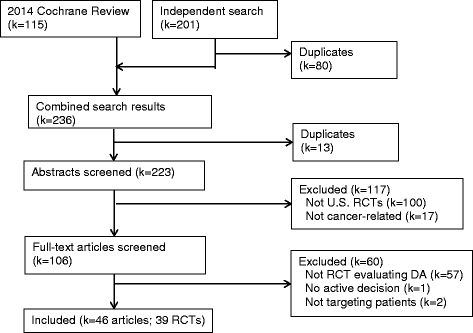Are cancer-related decision aids appropriate for socially disadvantaged patients? A systematic review of US randomized controlled trials
- PMID: 27267490
- PMCID: PMC4896023
- DOI: 10.1186/s12911-016-0303-6
Are cancer-related decision aids appropriate for socially disadvantaged patients? A systematic review of US randomized controlled trials
Abstract
Background: Shared decision-making (SDM) is considered a key component of high quality cancer care and may be supported by patient decision aids (PtDAs). Many patients, however, face multiple social disadvantages that may influence their ability to fully participate in SDM or to use PtDAs; additionally, these social disadvantages are among the determinants of health associated with greater cancer risk, unwarranted variations in care and worse outcomes. The purpose of this systematic review is to describe the extent to which disadvantaged social groups in the United States (US) have been included in trials of cancer-related PtDAs and to highlight strategies, lessons learned and future opportunities for developing and evaluating PtDAs that are appropriate for disadvantaged populations.
Methods: We selected cancer-related US studies from the Cochrane 2014 review of PtDAs and added RCTs meeting Cochrane criteria from searches of PubMed, CINAHL, PsycINFO (January 2010 to December 2013); and reference lists. Two reviewers independently screened titles/abstracts; three reviewers independently screened full text articles, performed data extraction and assessed: 1) inclusion of participants based on seven indicators of social disadvantage (limited education; female gender; uninsured or Medicaid status; non-U.S. nativity; non-White race or Hispanic ethnicity; limited English proficiency; low-literacy), and 2) attention to social disadvantage in the development or evaluation of PtDAs.
Results: Twenty-three of 39 eligible RCTs included participants from at least one disadvantaged subgroup, most frequently racial/ethnic minorities or individuals with limited education and/or low-literacy. Seventeen studies discussed strategies and lessons learned in attending to the needs of disadvantaged social groups in PtDA development; 14 studies targeted disadvantaged groups or addressed subgroup differences in PtDA evaluation.
Conclusions: The diversity of the US population is represented in a majority of cancer-related PtDA RCTs, but fewer studies have tailored PtDAs to address the multiple social disadvantages that may impact patients' participation in SDM. More detailed attention to the comprehensive range of social factors that determine cancer risk, variations in care and outcomes is needed in the development and evaluation of PtDAs for disadvantaged populations.
Trial registration: Registered 24 October 2014 in PROSPERO International prospective register of systematic reviews ( CRD42014014470 ).
Keywords: Cancer; Decision aids; Decision-making; Disparities; Social disadvantage.
Figures


References
-
- US Department of Health and Human Services. Healthy People 2020: An Opportunity to Address Societal Determinants of Health in the United States. 2010. http://www.healthypeople.gov/2010/hp2020/advisory/societaldeterminantshe.... Accessed 30 Nov 2015
-
- Centers for Disease Control and Prevention. Social Determinants of Health: Know What Affects Health. 2015. http://www.cdc.gov/socialdeterminants/index.htm. Accessed 30 Nov 2015.
Publication types
MeSH terms
Grants and funding
LinkOut - more resources
Full Text Sources
Other Literature Sources

